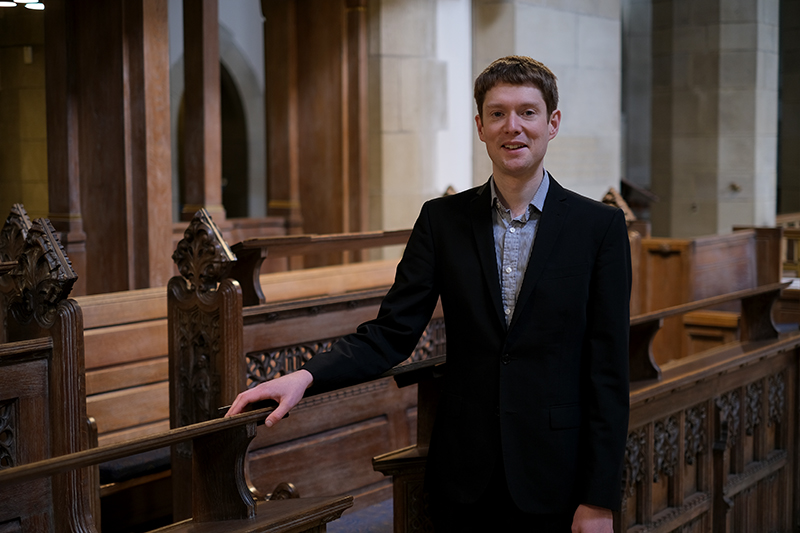On Wednesday 1st March 2023 we welcome Thomas Allery from London to the Cathedral for our next organ recital of 2023. In this edition of ‘Notes from an Organist’ we discover more about working with a music charity, a carol concert for the RNLI, playing on Burns Night and, of course, what to expect from his recital!
Could you introduce yourself, how you got into music / become an organist and your musical journey to where you are today?
Today I enjoy working in several places, and doing a variety of things! My typical week involves organ playing, choral conducting / choir training, playing the harpsichord, teaching, and research. I am lucky enough to work in two churches in Central London: St Mary-le-Bow (the church of the Bow bells) and Temple Church.
I also teach the organ and harpsichord at Radley College and the City of London School and continuo at the Royal College of Music. Alongside this, I play in and run a chamber group, Ensemble Hesperi. There is lots of variety, but really everything feeds pretty well into each other.
I got into music through my local church choir in the West Midlands. Here I was in the choir from a treble until the end of school, and I learned the organ at the church, so I got lots of opportunities early on to play for services. From there, I went to Worcester College, Oxford, as the organ scholar, then further study at the Royal College of Music and a year as the organ scholar at Canterbury Cathedral.
What can people expect from your recital at Bradford Cathedral?
Variety! There is a mixture of familiar and less familiar pieces to hear. Two works come from my recent project celebrating City of London church musicians (Edmund Thomas Chipp’s sketch and Ann Mounsey Bartholomew’s Introduction and Fugue), alongside the Mendelssohn sonata and the CPE Bach sonata which might more familiar to the audience, at least in terms of the musical style. As a visiting organist, it is always rewarding to play music from different schools on an organ to see how you can find different effects.
Why do you enjoy playing the organ?
I love the variety of repertoire the organ has to offer – we can play music from any period and across many styles. Exploring the variety of sounds available on different organs is always rewarding, from large cathedral organs to small instruments. In terms of expression, the organ presents a major challenge of course – everything we do in terms of expression is effectively the result of an illusion or trick – whether lengthening or shortening notes, adding stops (sometimes adding or taking off hundreds of pipes!), opening and closing swell boxes, all to create musical effects and phrasing. It’s a fascinating challenge!
Do you have a particular favourite piece out of those you are playing?
That’s hard to say as they are so different, but perhaps Pierné prelude actually. It’s a pianistic style work with a powerful build up to start the recital from a bubbling start to a very full sound.
This recital season we are celebrating music written by female composers. Which piece(s) have you selected, and why did you choose it / them?
This is the Introduction and Fugue by Ann Mounsey Bartholomew (1811-91). As I mentioned above, I discovered this piece because she was the organist of St Vedast Foster Lane, a church just along the road from my church, St Mary-le-Bow in the City of London. She was an amazing composer and musician, learning from Thomas Attwood and Samuel Wesley at St Paul’s Cathedral.
She was a noted pianist and composer, and in 1845 was the accompanist for the premiere of Mendelssohn’s Hear my Prayer. She was the organist of St Vedast for almost 50 years. The piece begins an arresting and stormy introduction with very expressive harmony, before leading into a fugue which feels slightly earlier in character. At times you can really hear the influence of Wesley through the textures and sequences.
Ann Mounsey Bartholomew didn’t write many pieces for organ so I guess what I love most about this piece is how it is like a window into the musical past. This is probably the sort of piece she would have improvised.
You work with the charity ‘Live Music Now’. Could you tell us more about that, and what your involvement is with it?
I am part of the Live Music Now scheme as part of Duo Hesperi, with Mary-Jannet Leith. We first joined them in 2018 and have had a great time doing all sorts of performances and projects. The charity was set up by Yehudi Menuhin and works alongside those with reduced access to live music, in care homes, schools, hospitals, hospices and community settings.
We are trained to deliver workshops primarily in special educational needs schools and in care homes. We take our harpsichord with us, and do a range of musical activities based, largely based on baroque music, but is has been a great opportunity to play all sorts of requests and arrangements! In these sessions, you really see the power of music at work, and realise how it is a language to connect to so many people. We have met the most amazing people!
You’ve written on your blog about your harpsichord and some of the questions you get asked about it – do you find a lot of people ask you about it?
Very much! And it’s always a joy to show people (usually in the intervals of concerts or as we pack up). Not many people see or hear harpsichords, so I love showing people how it works. They are often surprised at how quickly it can go into the back of the car!
You also wrote on your blog about music teaching in the time of Zoom. Have the restrictions of the pandemic changed the way music teaching works now?
To be honest, I don’t think they have changed the way we teach too much, apart from the realisation of how precious teaching and sharing music in person actually is. It has shown us how precious encounters with music are. In teaching, I probably demonstrate more now because I see how valuable it is for students to actually see someone playing their piece or showing a technique.
In lockdown teaching, a lot of time had to be spent describing something that would take 30 seconds to show in a simple demonstration! It has also shown use how training as a musician is a physical activity, with lots in common with training in a sport. To teach well, you have to be able to see how a student moves and interacts with the instrument, and be ready to react with ideas and suggestions – all of which is pretty spontaneous – again, impossible with the risk of a freezing zoom screen!
You are also part of ‘Ensemble Hesperi’. Could you tell us a little more about that?
Yes, this is a period chamber Ensemble of four core members (recorder, baroque violin, cello and harpsichord). We primarily perform music from the eighteenth century, and have made a name for ourselves performing Scottish baroque music (this is the research specialism of our recorder player, Mary-Jannet Leith). We perform across the country in festivals and concert series and also work with other artists – dancers, actors, singers, and other instrumentalists. Again, one of the joys is performing music which is often neglected, and introducing audiences to something new alongside something familiar. Do check out some of our clips on our website.
You recently played at a Burns Night event – was that fun to be involved in?
It really was! We were playing music we know very well as it is from our CD, Full of the Highland Humours, and so it was especially fun to play it within a Scottish themed evening.
Burns himself knew and respected the music of our main composer, James Oswald, so that a fun link for our very warm and welcoming audience. Just before the haggis supper was served, we played My love is like a red, red rose as an encore.
You were also involved with a Carol Concert on an RNLI lifeboat late in 2022?
Yes! One of my dreams is to become a volunteer crew on an RNLI lifeboat, so I wanted to get involved in the crucial fundraising life of the local lifeboat station (many people don’t realise that there are in fact four lifeboat stations on the river Thames).
Knowing that Christmas is a time when everyone loves to sing carols and support charities, I offered to lead some carols on board a boat at Chiswick pier by the lifeboats themselves. I was great fun to work with the team there (complete with singing crew in full gear) and with the local priest with whom I led the evening.
You have also been doing a research project – how has that been going?
My project on City composers has now been filmed and will be released in June this year (on my youtube channel). For this I had to choose a programme from a fairly large list of works and composers, so I still have many pieces to learn and programme in the years to come. I present the composers and their pieces at some locations around the City (including disused churches, and sites where churches used to be) so that it brings these stories to life for viewers.
Finally, how would you sum up your upcoming recital at Bradford Cathedral?
I guess really it is an exploration of the many sounds that the Cathedral organ has to offer. Through the programme, there will be chance to use so many colours and combinations of sounds to create different effects and match the musical characters. Hopefully the audience will feel a real difference between the music from the 18th century compared to more romantic sounds.
You can join us on Wednesday 1st March at 1pm for Thomas Allery’s organ recital, with an optional £4 buffet lunch beforehand at 12:30pm. You can also find out more about him on his website, on Twitter or Facebook.
You can discover more about our organ recital season on our dedicated page

